|
Consider a mass, m,
placed on a frictionless surface (therefore there will be no energy transfer
out of the system!), and attached to a wall by a spring.
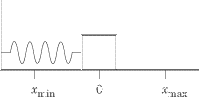
In
its equilibrium position x = 0 the mass is at rest.
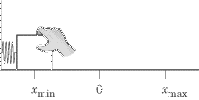
Let us push the mass
toward the wall, compressing the spring, until the mass is in position
xmin.
When you release the
mass, the spring will exert a force, pushing the mass back until it reaches
position xmax.
Now the spring will be stretched out, and will be exerting a force to
pull the mass back in toward the wall. Because we are dealing with an
idealized frictionless surface, the mass will not be slowed by the force
of friction, and will oscillate back and forth repeatedly between xmax
and xmin.
Hooke’s Law
The force, F, that the spring exerts on the mass is defined by Hooke’s
Law:
F
= -kx
where:
x is the
spring’s displacement from its equilibrium position and
k is a constant
of proportionality called the spring constant.
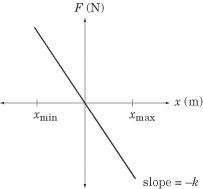
The spring constant
is a measure of “springiness”: a greater value for k signifies
a “tighter” spring, one that is more resistant to being stretched.
Hooke’s Law tells
us that the further the spring is displaced from its equilibrium position
(x) the greater the force the spring will exert in the direction of its
equilibrium position (F). We call F a restoring force: it is always directed
toward equilibrium.
Because F and x are
directly proportional, a graph of F vs. x is a line with slope –k.
Simple Harmonic Oscillation
A mass
oscillating on a spring is an example of a simple harmonic motion as it
moves about a stable equilibrium point and experiences a restoring force
proportional to the oscillator’s displacement.
For the
oscillating spring, the restoring force, and therefore the acceleration
(as F=ma), are greatest and positive at the extremes and zero at x = 0.
Important
Properties of a Mass on a Spring
The period of oscillation, T, of a spring is the amount of time
it takes for a spring to complete a full cycle. Mathematically, the period
of oscillation of a simple harmonic oscillator described by Hooke’s
Law is:

This equation tells us that as the mass of the block, m, increases and
the spring constant, k, decreases, the period increases. In other words,
a heavy mass attached to an easily stretched spring will oscillate back
and forth very slowly, while a light mass attached to a resistant spring
will oscillate back and forth very quickly.
The frequency
of the spring’s motion tells us how quickly the object is oscillating,
or how many cycles it completes in a given timeframe. Frequency is inversely
proportional to period.
Frequency
is given in units of cycles per second, or hertz (Hz).
The potential energy of a spring is sometimes called elastic
energy, because it results from the spring being stretched or compressed.
Mathematically it can be found as the maximum kinetic energy of the spring's
mass.
The potential
energy of a spring is greatest when the coil is maximally compressed or
stretched, and is zero at the equilibrium position. Hence the potential
energy, is zero at the midpoint and the mechanical energy is only
due to the kineticl energy.
At the points of maximum compression and extension, the velocity, and
hence the kinetic energy, is zero and the mechanical energy is
only due to the potential energy.

Vertical
Oscillation of Springs
Now let
usconsider a mass attached to a spring that is suspended from the ceiling.
The oscillation of the spring when compressed or extended won’t be
any different, but we now have to take gravity into account.
Equilibrium
Position
Because
the mass will exert a gravitational force to stretch the spring downward
a bit, the equilibrium position will no longer be at x = 0, but at x =
–h, where h is the vertical displacement of the spring due to the
gravitational pull exerted on the mass.
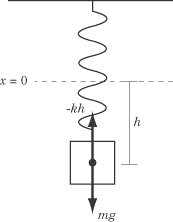 The
equilibrium position is the point where the net force acting on the mass
is zero - the point where the upward restoring force of the spring is
equal to the downward gravitational force of the mass. The
equilibrium position is the point where the net force acting on the mass
is zero - the point where the upward restoring force of the spring is
equal to the downward gravitational force of the mass.
The restoring
force, F = –kh, and the gravitational force, F = mg, therefore
-kh =
mg
and h=-mg/k
The mass
displaces itself more if it has a large weight (mg) and is suspended from
a spring with a small spring constant (slack spring!).
A Vertical Spring in Motion
If the
spring is then stretched a distance d, where d < h, it will oscillate
between (-h-d) and (-h+d).
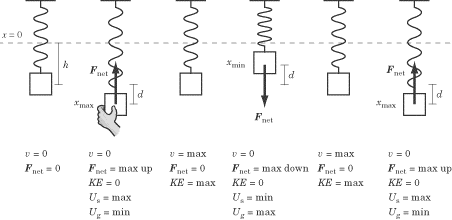
The force of gravity is constant and downward all of the time it is oscillating!
The
restoring force of the spring is always upward, because even at x (min)
the mass is below the spring’s initial equilibrium position of x
= 0.
Note
that if d were greater than h the restoring force would act in the downward
direction until the mass descended once more below x = 0.
According
to Hooke’s Law, the restoring force decreases in magnitude as the
spring is compressed. Consequently, the net force downward is greatest
at xmin and the net force upward is greatest at xmax.

For springs in series and parallel click here
Graphics
and notes adapted from sparknotes.com
|




 The
Oscillation of a Spring
The
Oscillation of a Spring






 The
equilibrium position is the point where the net force acting on the mass
is zero - the point where the upward restoring force of the spring is
equal to the downward gravitational force of the mass.
The
equilibrium position is the point where the net force acting on the mass
is zero - the point where the upward restoring force of the spring is
equal to the downward gravitational force of the mass.


